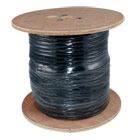Security Camera Cable & Wiring
What options do I have for wiring my security system?
There are two basic approaches to hooking up security cameras and digital video recorders (DVRs). You can use Plug and Play cable or you can use RG59 Siamese cable. Both cable types combine a cable for the video and a cable for the power.
The advantage of plug and play cable is that it is very easy to use. The connectors for power, video and audio are all pre-attached. All you have to decide is what length you need (we offer 25, 65, and 100ft. models). This cable type is a good choice for homeowners who don't need a cable run longer than 100ft.
The RG59 Siamese cable is more heavily shielded so it's more durable and can be run longer distances (up to 1000 ft. without a repeater). It's heavier shielding makes it less susceptible to interference. Florescent lighting in particular can interfere with camera signals. The RG59 is purchased in 500 or 1000 ft. rolls and each camera run is cut to the exact length needed. Since you need to cut the cable and attached the connectors, it is a little more involved to install.
What Is Plug & Play Cable?
 All you need to decide is what length of cable you need. Its recommended that you do not go over 100 feet with plug and play cable (or even shorter if florescent lighting is used at the installation site).
All you need to decide is what length of cable you need. Its recommended that you do not go over 100 feet with plug and play cable (or even shorter if florescent lighting is used at the installation site).
Click here to see the plug and play cables we have available on our site.
The video and audio connections on the plug and play cables are RCA male (this is typical). All of the DVRs and cameras on our site have BNC male connections. Therefore, when using plug and play cables with our cameras and DVRs you will also need to use our RCA to BNC connectors.
Note: If using the plug and play cable to connect directly to a TV you probably wont need any connectors as most TVs provide a simple RCA (female) input so the cable can plug directly into it.
What Is RG59 Siamese Cable?
 RG59 Siamese cable is a heavily shielded cable which contains both the video (COAX) cable and the power cable (18 gauge 2 conductor) in one jacket. The advantages to using this cable is that its more durable, and you can run it long distances without interference. Also, you can cut each camera run for the exact length that you need. If you are using a camera with audio or a PTZ camera (which requires a data cable connection) you will need to use a special type of RG59 which includes an additional data wire in the jacket (see model CAB500D).
RG59 Siamese cable is a heavily shielded cable which contains both the video (COAX) cable and the power cable (18 gauge 2 conductor) in one jacket. The advantages to using this cable is that its more durable, and you can run it long distances without interference. Also, you can cut each camera run for the exact length that you need. If you are using a camera with audio or a PTZ camera (which requires a data cable connection) you will need to use a special type of RG59 which includes an additional data wire in the jacket (see model CAB500D).
We have 500 ft. rolls and 1000 ft. rolls of RG59 Siamese available (click for details).

Step 1:
Use a stripping tool to strip the shielding from the coax part of the cable. You can order a good quality stripping tool here. In order for the connector to go on smoothly you will want about 3/4" of the center conductor showing and about the same amount of the copper wire braid showing (see figure 2).
Step 2:
Make sure that none of the strands of copper wire braid touches the middle conductor wire when you twist on the BNC connector. If they accidentally touch, this will not damage the camera but can result in a black (shorted out) image from the camera.
Step 3:
Twist on the BNC Connector onto the wire until it is snug. You will repeat Steps 1 - 3 for the DVR end of the COAX cable as well as the camera end (see figure 5).
Step 4:
Cut the wire on the camera power supply about 6 to 12 inches from the camera connector. Strip back the wire (on both parts) 1/2 inch or so to expose the white (positive) and black (ground) wires.
Step 5:
Using wire nuts, connect the white wire of the power supply to the red wire of the RG59 2 conductor, and the black (ground) wire of the power supply to the black wire of the 2 conductor.
The diagram on the right is an overview of the process required to use RG59 cable for camera installations.
Preferred Solution:

On the camera end, a preferred method is to use a PWRADT 2.1mm pigtail connector (see below). This provides a cleaner connection on the camera end. You simply use pliers to crimp down the power wires to the connector, and the other end plugs into the camera.
On the DVR end, a preferred method is to use one of our professional power boxes. The power box is usually installed near the DVR. The 2 conductor power wires from the RG59 will connect directly to the power box. This method is recommended because the installation is cleaner and more robust.
Last Modified: Jun 1, 2010